Sun Salutation: Surya Namaskara A
Note: Touch or hover your mouse over underlined terms for a definition.
Ashtanga-Vinyasa practice begins with the performance of this sequence, typically repeated 5 times.
This sequence of 9 movements can be considered the foundation for the rest of the practice. Each pose of the sun salutation is the archetype for a family of postures. There is something to learn and master from each.
Surya Namaskara is also an ideal way to begin the practice because it works with the major joints. It can vary from a gentle warm-up and exploration for beginners, to an expression of strength and grace for more advanced practitioners.
(Click this image for full size – 5112 px):
Surya Namaskara A consists of 9 movements (Samasthiti, neutral position, is not counted).
This is a brief cueing of the Sun Salutation for your reference in practice, followed by full descriptions of each vinyasa.
0. Samasthiti
Stand upright, and the body aligning on a central vertical axis.
1. Inhale, reach up overhead stretching the whole body.
2. Exhale, fold forward and press the palms down.
3. Inhale, look forward and lengthen the front of the body, reaching through the crown of the head.
4. Exhale, plant the palms and hop back to chaturanga.
5. Inhale, pull the heart forward through the arms and fan the ribs open. Drag the feet along the mat and lengthen the lower back.
6. Exhale, roll over the toes and lift the hips up and back to downward facing dog. Lift with the strength of the legs to pull the spine taut and long.
7. Crouch, look forward and hop both feet forward. Inhale, look forward and lengthen.
8. Exhale, fold fully and press the palms down.
9. Inhale, lift through the crown of the head to standing and lift through the fingertips.
0. Exhale, Samasthiti.
These positions are commonly referred to throughout Ashtanga practice by their number rather than name. For example, Catvari (four) for chaturanga, Panca (five) for Urdhva Mukha Svanasana, Sat (six) for Adho Mukha Svanasana.
Or, listen to this audio recording leading you through 5 Surya Namaskara A.
Step by step
0. Samasthiti – Equilibrium:
With the big toes touching and the heels slightly parted, lift the toes up, waking up the soles of the feet. Check your balance to make sure your weight is even; not standing on one foot more than the other. Draw the ankles towards one another to feel the outer arches of the feet lift and become defined. This should give the sensation of the roots of the big toes pressing down firmly. You may also feel some weight shift back towards the heels. Reach down through the heels
Engage the quadriceps, lifting the kneecaps to actively balance.
Straighten the spine and elongate the crown of the head towards the ceiling by extending the heels down into the earth, bringing the spine into a long, taut position.
In this position (and many yoga positions), we attempt to reduce these curvatures to lengthen the spine and decompress the vertebrae, which has the effect of increasing your height. In other words, the spine moves from a curvy S position – or, in some cases, the spine may have one dominant curvature, with the appearance of a ‘ ( ‘ – towards a straight line: |
It is not desirable for the spine to actually become straight, but that is the easiest way to describe the feeling of this posture, which strengthens the spine and reduces any excess curvature. This movement is done in several stages:
- Pelvis floating between the two extremes of rotation. Depending on your spine, you may need to rotate it either anteriorly (‘lift’) or posteriorly (‘tuck’) to find a neutral rotation that supports the lower back.
- Lift the rib cage and expand the chest and back – this is accomplished by spreading the shoulder blades to the sides (laterally) rather than squeezing the shoulder blades together behind the back. Be careful not to bend backwards. At the same time, the abdominals are engaged to prevent the bottom edge of the rib cage from ‘flaring.’ (You can check using your hands – if you can clearly feel the bottom ribs, “tuck” the ribs into the abdomen.)
- Reposition the shoulders by lifting the arms in front of you, stretching the shoulders forward, then lifting the shoulders towards the ears, then moving the shoulders backwards, then bending the arms at a 90 degree angle and pressing down through the elbows towards the ground and slightly to the side. Continue to expand the shoulders to the sides as described in the previous step. After the shoulders are in position, bring the palms to hover by the sides of the thighs, but keep a slight tilt in the elbow and keep the muscles of the arm lightly engaged by reaching the fingers towards the mat.
- Look down the length of the nose to feel the back of the skull lifting very slightly from the vertebrae of the neck. The head often needs to move back slightly in space so that the ears float above the shoulders.
The state of Samasthiti is feeling that the entire body is aligned on one central, vertical axis that pases through the center of the body along the inside edge of the spine, extending up through the crown of the head and down from the tailbone to the heels, into the earth.
You are now ready to begin Surya Namaskara A.
Vinyasa Ekam (One)*:
Breath: Inhale
Gaze: Thumbs
(* in Ashtanga-Vinyasa, these movements are typically referred to by number rather than name)
From Samasthiti, press down into the heels as you turn the palms to face outwards and sweep your heads up overhead, stretching through the fingertips. Palms meet overhead, and the chin lifts towards the ceiling as you gaze up at the thumbs. The rest of the body remains aligned in the previous posture.
Let the shoulder blades slide up the back, wrapping around the sides of the ribs. You can encourage this wrapping by pressing the pinky fingers together firmly as you lift the arms strongly to the ceiling.
There can be a certain feeling of luxury in this posture as the whole body stretches and lengthens. Create a feeling of lightness, reaching the heels into the earth and the fingers to the sky so that the waistline is pulled long and taut.
Vinyasa Dve (Two):
Breath: Exhale
Gaze: Nose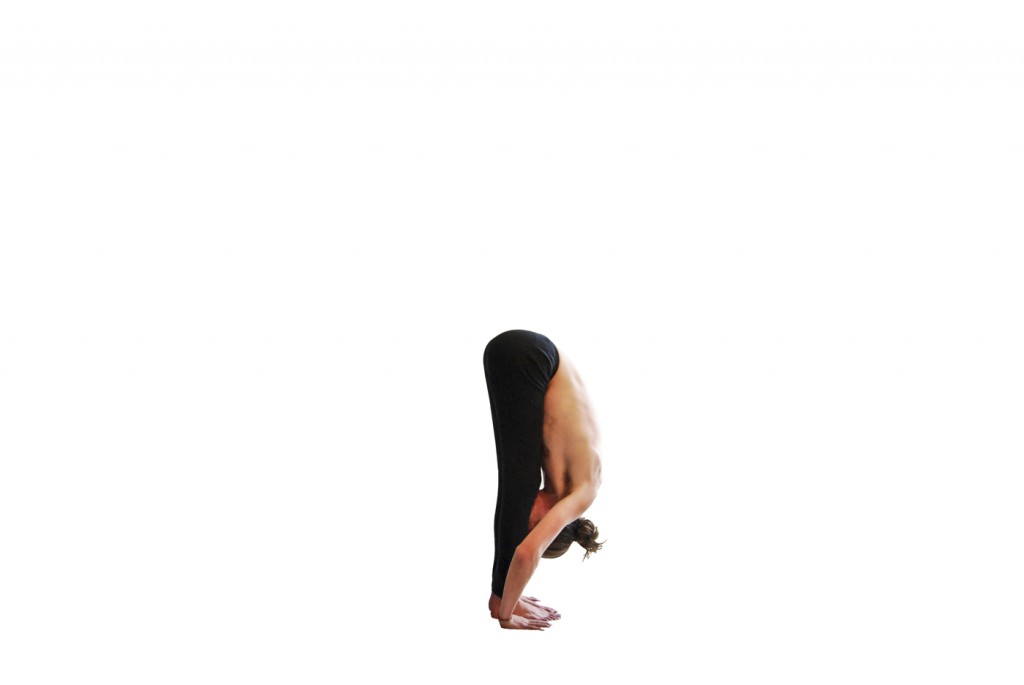
Fold crisply at the hip crease, initiating by pressing the center of the chest (sternum) forward, and then folding with a length in the spine. Emphasize the feeling of length and spaciousness as you fold – it may even feel like a slight backbend – rather than curling the head towards the knees. Press the palms down into the mat so you can feel the strength and connection of the arms to the earth.
Keep the abdominal muscles soft and relaxed, so that the waistline can lengthen and the ribs slide down the thighs towards the knees. Crunching the abdominals in will prevent a full forward fold and shorten the spine.
You may find it is necessary to bend the knees as necessary to keep the back straight and bring the palms to the floor, but maintain a sensation of strength in the legs by pressing the feet into the mat.
Vinyasa Trini (Three):
Breath: Inhale
Gaze: Upward / Third Eye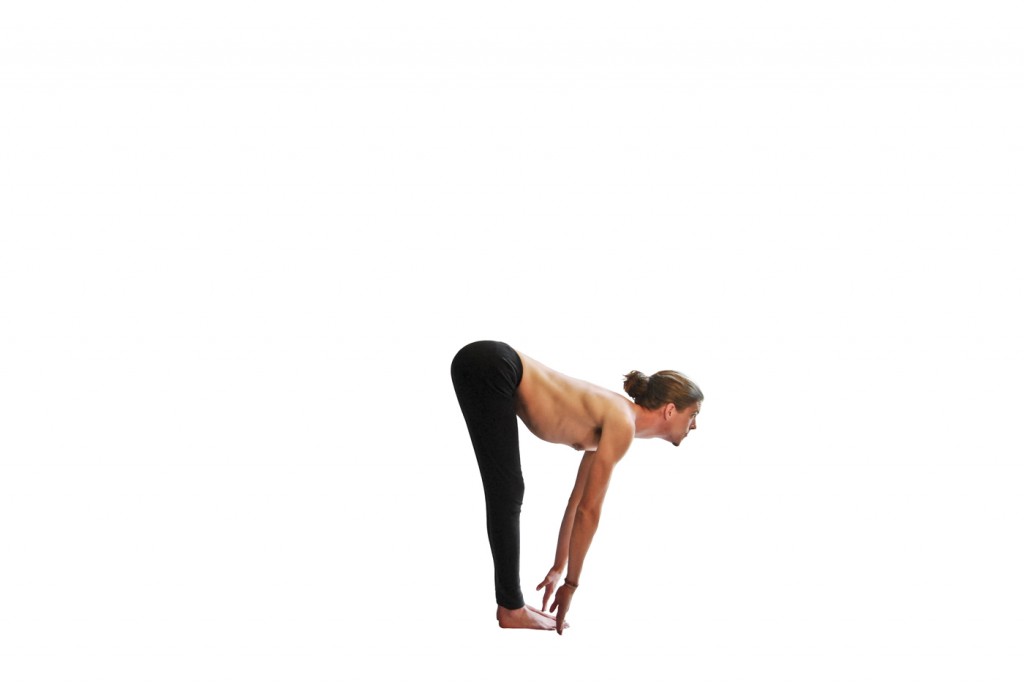
Lift the head, straightening and lengthening the back as you lift the palms off the ground so only the fingertips touch the mat. Pull gently with the fingertips to lengthen the spine. Reach the sternum down towards the toes, attempting to make the back concave. Rotate the hips anteriorally, lengthening the hamstrings. Broaden the shoulders and collarbones.
This repositioning of the body is necessary to ensure proper alignment for the coming jump-back. In extremely flexible practitioners, the palms may be kept on the ground, but there must be a significant ability to lift the torso and create curvature in the back from the previous position.
Vinyasa Chatvari (Four – Chaturanga Dandasana):
Breath: Exhale
Gaze: Forward
There are a number of ways to jump back to chatvari.
One option, for those with an injury, is to step one foot back at a time. This will help prevent any shock to the knees / low back / shoulders that could exacerbate injury.
If possible, make the effort to jump, even if it feels clumsy or awkward. The first step is to press the hands into the ground and feel the heel of the hand connecting down to the mat. Knees may need to bend slightly to feel that connection if the body feels tight or restricted.
A major block is being willing to trust the hands and arms to support the body’s weight. Most people are not used to supporting themselves with their arms rather than their legs.
Once the hands are down to the mat, lean forward slightly so that you can feel weight down into your fingertips and the feet lightening slightly on the mat. Hop the feet back however you can manage, landing with straight legs and straight arms.
The method of lowering down is very important to prevent injury and ensure strengthening in the proper areas of the body.
Once in the “high plank” position, lift the knees up towards the ceiling so the legs feel very strong. Press the toes firmly into the mat. Reach the roots of the index fingers down into the mat, rounding the back and lifting the upper back towards the ceiling, filling the space between the shoulder blades.
Start to bend the elbows towards the toes, still pressing into the hands. Most likely, as you start to bend the elbows to lower down, the shoulder blades will pinch together. You may only be able to lower an inch or two while keeping the back broad.
Trying your hardest to keep the shoulders broad, lower down however possible. Over time, this movement will strengthen. Unless you have an injury to the shoulder, it is okay to be patient with this process and you will notice that after some time of practice you can keep space in the upper back.
If you do have an injury to the shoulder girdle, it may be detrimental to lower all the way down with poor alignment. In this case, stay lifted up high and just work on lowering down an inch or two. Do not go past the point where you start to loose strength and alignment.
Once you become accustomed to this movement, it’s time to work on the method of jumping back.
Visualize the hips lifting up over the shoulders and wrists as you hop. The movement starts as an upward movement, and then the legs reach back to find chaturanga. Focus on the bandha, and especially the feeling of mulha bandha lifting up and aligning over the rest of the spine. The legs may be slightly bent at this stage, which is fine. Focus primarily on trying to find a sensation of “slowing” the jump down, as if the air offered a slight resistance. The body may begin to have a feeling of “floating” as the shoulders and arms become more stable.
As the jump back slows, play with bending the arms so you end up in the chaturanga position. This has the effect of the jump feeling more controlled, and it also acts as a “shock absorber,” reducing any feeling of jarring or impact as you jump back.
One of the main sources of feedback you have for jumping is your hearing. Work on making landing as quiet as possible.
A more advanced method of jumping back, once the previous technique becomes comfortable, is to work on dead-lifting the legs.
Place the palms down to the ground, then lean forward over the fingers. Lift the feet up off the ground (I find it helpful to lift the toes up), then raise the legs to a 90-degree “pike” position. Do not “jump” from the legs. Instead, isolate the strength of the shoulders connected to the long, core strength of the spine. It may help to visualize or feel the movement of the breath along the inside edge of the spine and the lift of the bandha.
Once the legs are lifted up, pause for a moment finding balance on the hands. Then, start to bend the elbows to initiate the downward movement. The feet reach back to find the mat, landing silently.
No matter which method you are practicing, take a moment to exhale fully in the final position: pause for a moment here and give this asana the time it deserves; do not rush into the next vinyasa.
Vinyasa Pancha (Five -Urdhva Mukha Svanasana/Upward Facing Dog):
Breath: Inhale
Gaze: Down the length of the nose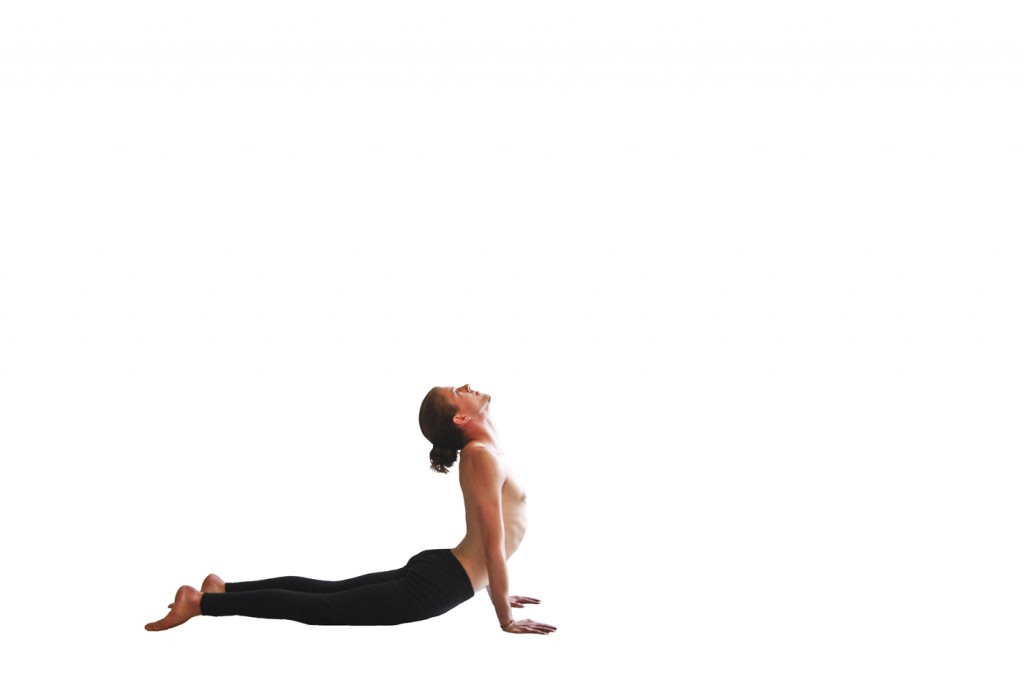
Straighten your arms as you drag your body forward through the gate of the arms. Roll over onto the tops of the feet and press down through the tops of the feet, dragging the feet forward along the mat by the strength of the arms. Performed properly, the opposing movement between the hands and feet creates traction that will lengthen the spine rather than compressing the lower back.
Only the palms and tops of the feet touch the mat – the legs and knees are lifted completely.
Press down through the shoulder blades, lifting the chest and shoulders so that they are broad and open. This action also helps to to avoid pressing the shoulders up around the ears. If you are unable to maintain this position, bend the elbows slightly, walk the hands forward, or both. As you practice, gradually straighten the elbows while keeping the shoulders down.
Backbends often cause a pinching or pain in the lower back for beginners. Ensure a full opening of the upper back by looking down towards the navel as you start to pull forward from the previous vinyasa. Lift the chest into the chin, and then as the upper body comes into position, let the head reach up and back as the finishing touch of the movement. If you lead the movement with your head rather than your heart, it can create strain in the neck and restrict the opening of the back.
In case of neck injury or pain, look forwards, keeping the neck straight.
Keep the muscles of the buttocks and the long muscles of the back relaxed. If they tighten in this position, you will experience limited flexibility and increased compression of the spine.
As in many backbends, try and emphasize the strength of the front of the body rather than of the back. Lifting the knees up as you press the feet down into the floor helps to find the strength of the quadriceps. By the action of the arms, try to find a feeling of strength across the arc of the collarbones, lifting the ribs forward and through the arms. The bandha serve to provide stability and length to the lower back.
After some practice, the movement from chatvari to pancha can feel like wind blowing into a sail, causing it to billow forward.
Vinyasa Sat (Six – Adho Mukha Svanasana/Downward Facing Dog)
Breath: Exhale
Gaze: Downward (or knees)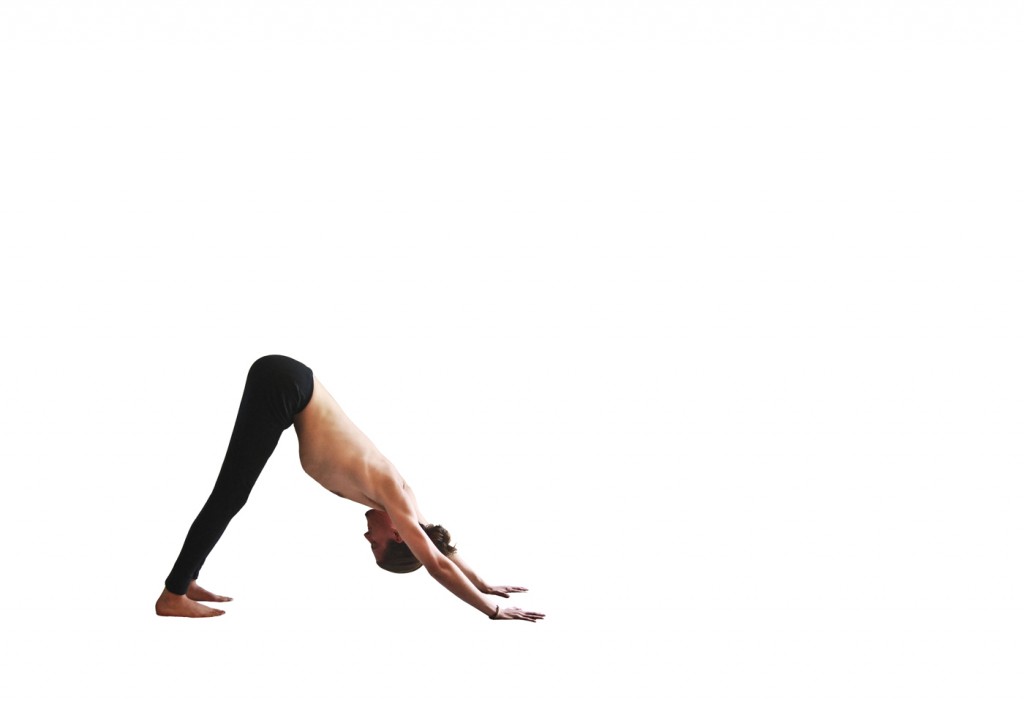
Press down through the palms as you lift your pelvis towards the ceiling, straightening the legs. Roll the feet so that the soles come into contact with the mat. If this is uncomfortable on your toes, switch one foot and then the other.
Feet can be hip width apart to allow full activation of the leg muscles.
Create a long, taut line in the upper body in downward facing dog. Imagine a board laying flat all the way from the wrists, up the back, to the hips. (You can actually get a board if you want to test it!)
If the hamstrings and shoulders are pretty tight, making the back rounded, encouraging an anterior rotation of the pelvis can help straighten everything out.
Some practitioners are capable of “hyperextending” in downward facing dog, meaning the back is deeply arched (lordotic) and the head and chest are coming down towards the ground. This can create a feeling of pinching or pain in the lower back.
Do not try to press the ribs to the toes. Instead, try to find the strength of the legs to lift the sitting bones and pubic bone up and back (diagonally, away from the hands). Finding a very slight action of posterior tilt in the pelvis can be helpful, but only 2-5 degrees. Quite subtle — just enough that you can feel the strength of the legs and a feeling of suction or “hollowing” in the belly. The abdominal muscles should be fully relaxed, giving the appearance of a narrow waistline.* If you’re very flexible, you’ll find you actually have to lift up away from the ground. Press into the finger tips, and lift from the hip creases to feel like you’re being stretched long and taut. The back should the long, feeling a stretch of the spine (axial extension) as if you were laying in an inversion table.
After finding the correct position, you will not have any pain in the lower back or shoulders and the whole body will feel very buoyant and light. The legs work very hard here, and pushing into the fingers (especially the index finger) creates a feeling of lightness in the shoulders.
*Note that the narrowing of the waistline has nothing to do with being skinny, it’s a muscular action – or in this case, a muscular release.
Take five mindful breaths in this vinyasa.
Vinyasa Sapta (Seven)
Breath: Inhale
Gaze: Fingers / Forward
Start by bending the knees deeply and pressing into the toes , lifting the heels high. Bring the ribs and knees together, and reach the fingertips into the ground to lengthen the arms and shoulders. Look forward between your hands.
As with the jump-back, jumping forward is quite challenging. After crouching as described above, there are a few different options
- Step one foot forward at a time (if you have an injury)
- Hop the feet forward together. It is not necessary that the feet come all the way forward between the hands at first. Focus on lifting the hips up high. The knees can bent. Once you land, step forward and straighten the knees if possible.
- From crouching, jump by straightening the legs. Glide the feet just over the mat and land between the hands. Avoid bending the knees and jumping the feet up towards the ceiling. As you jump, bring the hips forward enough that you can start to play with finding balance in the fingertips.
- Once you’re comfortable with jumping forward, move from crouching to pike-handstand. After taking a moment to feel the balance from the fingertips up through the spine to the tailbone, start to fold the legs to the chest, slowly. Let the feet hover an inch or two above the mat for a moment, then set the feet down with control.
Once you’ve got the feet forward, inhale and look forward, straightening and lengthening the spine
(Same as the third vinyasa)
Vinyasa Ashtau (Eight)
Breath: Exhale
Gaze: Nose
Fold forward from the hips, drawing the navel and lumbar spine close to the thighs (by engaging the psoas and quadriceps). Palms press down to either side of the feet.
This is the same as vinyasa two.
Vinyasa Nine:
Breath: Inhale
Gaze: Thumbs
Starting the movement from the crown of the head, lift with a slight arch in the spine. Hands spread wide to the sides and then join overhead.
Take the time to find length in the spine, extending down through the heels and up through the fingertips.
This is the same as vinyasa one.
0. Samasthiti – Equal Standing Posture: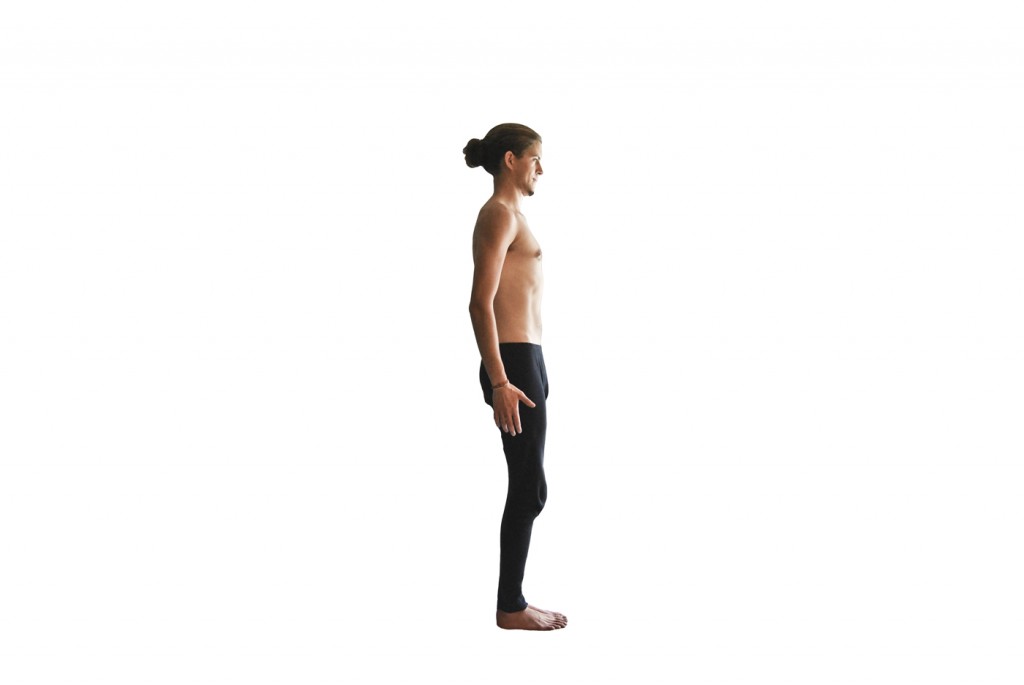
This is one complete Surya Namaskara A.

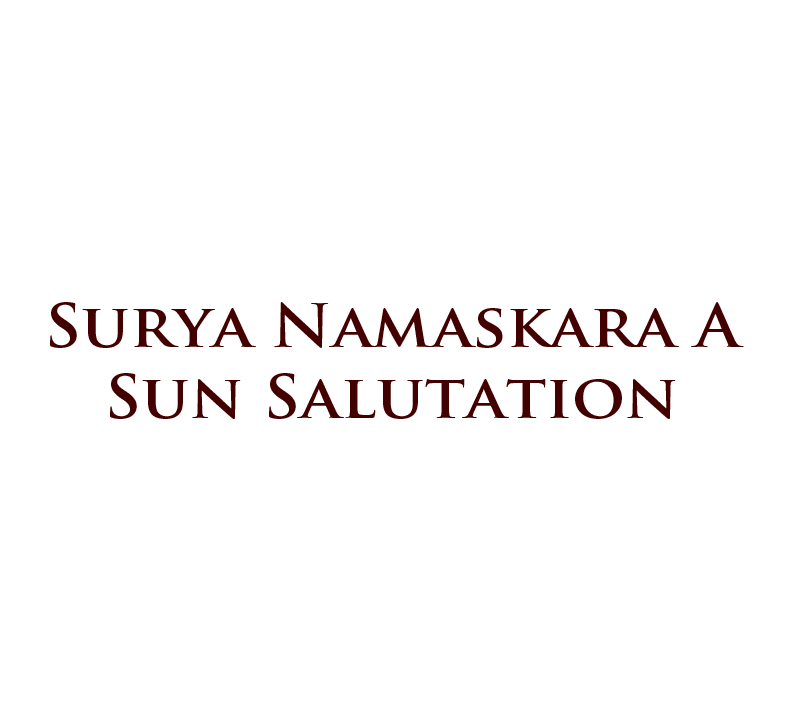

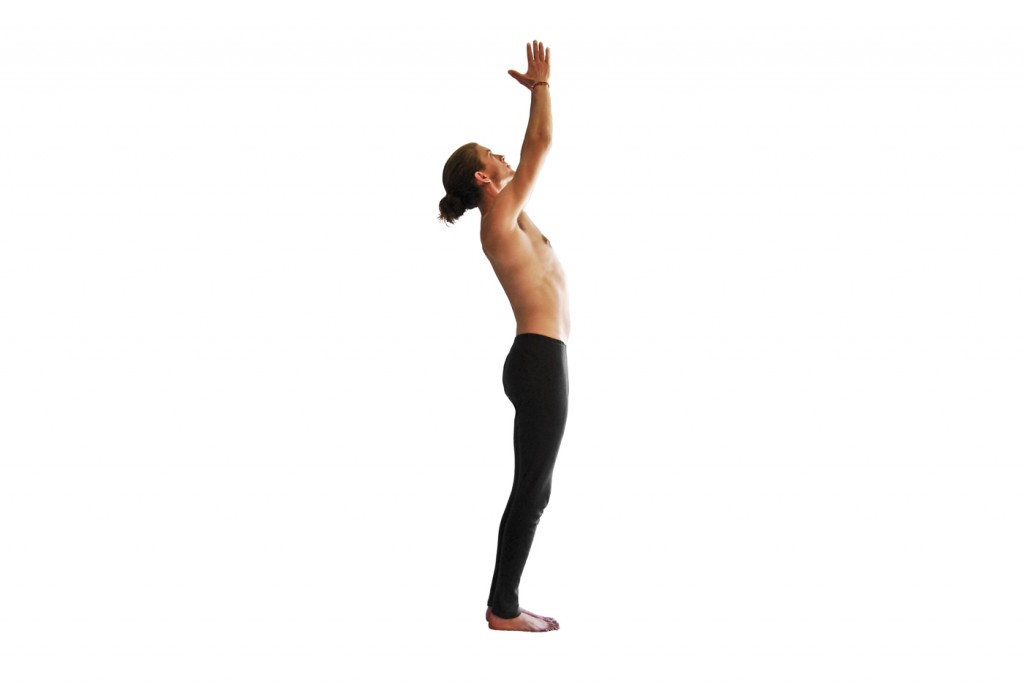


[…] of Surya Namaskara B follows Surya Namaskara A. It is typically performed five times, but this may vary depending on the practitioner and the […]
[…] Surya Namaskara A for discussion of […]
[…] Sun Salutation: Surya Namaskara A […]
You made some respectable factors there. I regarded on the web for the issue and found most individuals will go together with with your website.
I’m impressed, I have to say. Actually hardly ever do I encounter a weblog that’s each educative and entertaining, and let me tell you, you could have hit the nail on the head. Your concept is outstanding; the difficulty is one thing that not enough persons are talking intelligently about. I’m very completely happy that I stumbled throughout this in my search for something relating to this.
Thank you for an excellent session today! I appreciate all the assistance in helping me build a better practice! ^_^
I love what you’ve done with the Asana Project so far. Please feel my encouraging support to continue your good work! Your images already come up quite high in the google image search, so you have a wide reach. I love your trikonasana breakdown, and the pelvic tilt explanations—such valuable diagrams. Thank you.
[…] Caption: This yoga site breaks down many core sequences in yoga, and provided the graphic below to outline Surya Namaskara A. […]
Hi thanks but what about width of hands/ feet?
Lengths of the big toes touching. Heels spaced slightly apart, so that the outside edges of the feet are more or less parallel to one another. Hands close to either side of the feet with the tips of the fingers and toes in line.
In catvari, pancha, & sat positions (chaturanga, upward & downward facing dog), feet about one-foot-width apart (hip distance), aka femurs parallel. Arms (humeri) parallel to one another, also.
that was some sick transitions on the sun salutaion